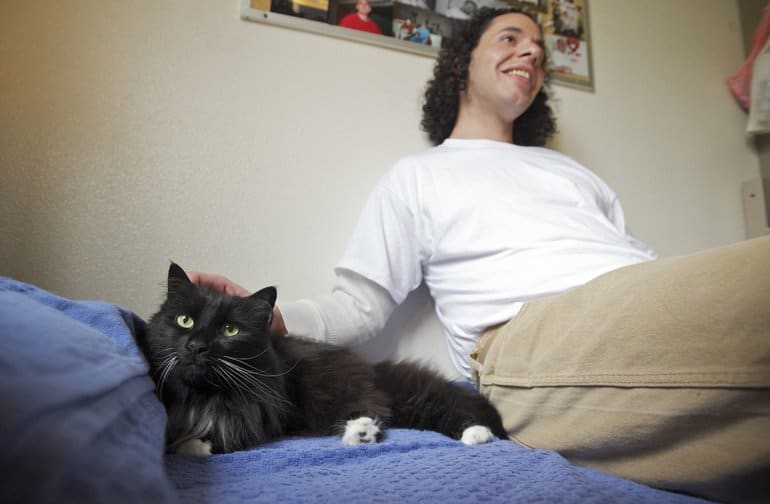Cats have a knack for claiming the most inconvenient spots as their own. Whether it’s a desk, dining table, or favorite reading chair, our feline friends always seem to put themselves exactly where we don’t want them to be. But don’t worry, with some patience and training, you can teach your cat some boundaries and take back some control of your space.

Why Your Cat Insists On Climbing On Your Stuff
There are a number of reasons why cats may choose to walk, play, or lounge across our desks and dining tables. Understanding the reason YOUR cat is doing it is the first step in changing the behavior. Here are a few of the most common reasons:
- Cats Are Attention Junkies: Some cats may simply want attention from their owners and will try to get it by being in their space. If you notice your cat constantly jumping onto your desk or table while you’re working or eating, try giving them some extra playtime or snuggles beforehand to see if that curbs their behavior.
- Cats Love High Places: Most cats naturally gravitate towards high places. It’s in their DNA. Elevated spots offer them a good vantage point to observe their surroundings and feel secure. Your table or desk might be the perfect lookout tower for your curious kitty.
- They’re Curious: Cats are naturally curious creatures and like to explore new spaces. It’s easy to see why your desk or dining table may seem like an interesting place to investigate, with lots of objects to jump on and play with.
- It’s a Learned Behavior: If your cat has been allowed on the forbidden surfaces in the past, they may continue to do so because they still think these are acceptable spots for them. In this case, it will take some time and consistent training to break the habit.
How To Teach Your Cat to Stay Off Your Desk or Table
Make the Space Unattractive or Boring to Your Cat
Once you’ve determined WHY your cat won’t stay off your desk or table, changing the annoying behavior could take just a few simple changes. For example, if your cat is simply seeking your attention by invading your space, don’t give them any! Instead, try to recognize and praise them with treats or scratches when they’re spending time in a more appropriate place.
If your cat can’t ignore his own curiosity, make the space less interesting to him. Keep your desk and/or dining table clear of the items your cat is intrigued by. The less there is to explore (or knock over), the less likely your cat will want to spend time there.
Provide Your Cat With More Appealing Alternatives
If you suspect your cat is using your desk as a vantage point for observing his territory, or perhaps as a safe zone out of reach of other pets or kids, offer a more suitable alternative. Tall cat trees provide a vertical territory with scratching posts and perches. Curbing the unwanted behavior could be as simple as placing a cat tree next to your desk – especially if your height-loving cat can observe (read: judge) you from his new special spot. Window perches are another great option. They satisfy your cat’s love for heights and provide entertainment as they watch the world outside. This can be a fun alternative to your desk or table.

If your desk or dining table is a veritable playground for your cat, in addition to keeping your space as clear as possible, provide kitty with other exciting playthings! Interactive toys can engage your cat’s natural hunting instincts and divert their attention from your workspace. Toys that mimic prey can keep your cat entertained and satisfy their need for mental and physical stimulation. Of course, a nice exhausting play sesh with their human before work or dinner time could keep them contented enough to stay out of your space.
Use Positive Reinforcement to Teach Your Cat Boundaries
Positive reinforcement is key to successful cat training. Reward your cat with praise and treats when they use the alternatives you’ve provided. This encourages them to continue the desired behavior. Just remember, learning is a process and it won’t happen overnight. If you catch your cat on your desk or table, gently pick them up and place them in a more appropriate spot and reward them there. This redirection and reinforcement helps them understand where they are allowed to be.
It’s also important to avoid punishment like smacking, yelling, or spraying your cat with water, when trying to teach your cat to stay off your desk. Punishment can damage the trust between you and your cat and create stress for you both. Plus, if your cat is an attention-seeker, the attention he gets (yes, even negative attention) is only reinforcing the bad behavior.
As author Jade King wisely said in her book, Cat Behaviour Guide: How To Train A Cat, Stop Cat Problems For Good, “Cats, just like kids, respond positively to affection and rewards.”
When Safety Is A Concern, Use Non-Harmful Deterrents

In some cases, you may simply not have the time necessary to train your cat to stay off your table, especially if your cat’s safety is a concern. In this case, you may want to consider a non-harmful, gentle deterrent. Double-sided tape and scat mats (rough plastic mats) are non-harmful textures that can deter your cat. Cats dislike the sticky feel of tape and the rough texture of scat mats, making these surfaces less attractive for lounging. Aluminum foil is another great deterrent. The sound and feel of it are generally unpleasant for cats. You can place sheets of aluminum foil across your table or desk to keep your cat away.
Consistency is Key When Training Cats
Consistency is crucial in training your cat. It’s important to apply these methods consistently and be patient. Training takes time and repetition, but with perseverance, you can achieve success! Remember, your cat isn’t intentionally trying to sabotage your work or dinner time. They just have different instincts and behaviors than humans. With a little understanding and effort, you can teach them the boundaries they need to live harmoniously in your home.




